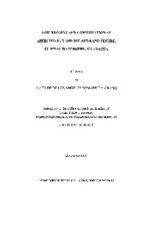| dc.creator | Somarriba-Chang, Matilde de los Angeles | |
| dc.date.accessioned | 2012-06-07T22:50:36Z | |
| dc.date.available | 2012-06-07T22:50:36Z | |
| dc.date.created | 1997 | |
| dc.date.issued | 1997 | |
| dc.identifier.uri | https://hdl.handle.net/1969.1/ETD-TAMU-1997-THESIS-S658 | |
| dc.description | Due to the character of the original source materials and the nature of batch digitization, quality control issues may be present in this document. Please report any quality issues you encounter to digital@library.tamu.edu, referencing the URI of the item. | en |
| dc.description | Includes bibliographical references: p. 124-129. | en |
| dc.description | Issued also on microfiche from Lange Micrographics. | en |
| dc.description.abstract | Erosion by water is a serious problem threatening the sustainability of steep land agricultural production throughout the tropics. The El Pital watershed is typical of the many regions within Nicaragua where the effects of erosion are increasingly evident. Analysis of aerial photographs taken in 1968 and 1987, and comparing them with conditions in 1996, indicates that erosion has increased throughout this period and is substantially above the expected geologic "natural" erosion rate for the area. This trend is associated with increased fragmentation of farms associated with the agrarian reform activities of the 1980's, during which many of the large land-holdings were confiscated and redistributed to many peasant families. Also the increasing population and inheritance customs have contributed to the proliferation of smaller fanning units. Small farming units (< 4 ha) are linked to increased erosion because small farms tend to emphasize production of annual crops necessary to meet the subsistence needs of the farm family. Annual crop production is a land use that has a high erosion risk because the soil is more exposed to raindrop impact and there is less vegetative obstruction to overland flow than if the land use was forest, range, or a perennial crop with high cover characteristics, such as coffee. The trend within the watershed toward increased emphasis on annual crop production is greatest on the steep lands where the erosion risk is naturally high. The increase of small farms on the steep land is a function of political and economic considerations, which make these lands most available for settlement. Most of the institutions working in the watershed to encourage soil conservation have targeted the beneficiaries of agrarian reform. The result has been greater on these farms than on the lands that were traditionally privately owned. This illustrates that extension activities do make a significant difference in adoption of soil conservation practices. Because the trend within the watershed is toward an increase in small farms, and because the trend on small farms is to select crops with a high erosion risk, there is a need to design and implement programs that enhance adoption of soil conservation technologies by these small farmers. | en |
| dc.format.medium | electronic | en |
| dc.format.mimetype | application/pdf | |
| dc.language.iso | en_US | |
| dc.publisher | Texas A&M University | |
| dc.rights | This thesis was part of a retrospective digitization project authorized by the Texas A&M University Libraries in 2008. Copyright remains vested with the author(s). It is the user's responsibility to secure permission from the copyright holder(s) for re-use of the work beyond the provision of Fair Use. | en |
| dc.subject | rangeland ecology and management. | en |
| dc.subject | Major rangeland ecology and management. | en |
| dc.title | Soil erosion and conservation as affcted by land use and land tenure, El Pital Watershed, Nicaragua | en |
| dc.type | Thesis | en |
| thesis.degree.discipline | rangeland ecology and management | en |
| thesis.degree.name | M.S. | en |
| thesis.degree.level | Masters | en |
| dc.type.genre | thesis | en |
| dc.type.material | text | en |
| dc.format.digitalOrigin | reformatted digital | en |


